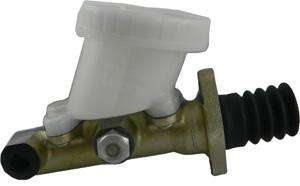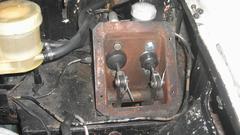The MGA With An Attitude
DUAL LINE MASTER CYLINDER on the MGA - BT-206
This question pops up and the proposition gets kicked around occasionally. "Are you familiar with anyone doing a conversion on the MGA brake system to make it a duel line system"?


Yes, and it's more than a bit of a fiddle. Piping in the dual fluid lines between the master cylinder and RF corner of car is not much of a problem, but the master cylinders are. You would need a two-circuit master cylinder and a separate clutch slave cylinder. Most of the 2-line master cylinders are longer and would require cutting a hole in the bulkhead, followed by fitting an extended cover plate behind to close the hole. You also need new brackets to hold the new master cylinders and pedal pivots, enlarge the hole in the heater shelf, relocate bolts for the pedal excluder boot and retaining ring.
If I was to try this I might start with a complete matched assembly of master cylinders, brackets and pedals from another car, late model MGB perhaps, then adapt the sheet metal of heater shelf and bulkhead to match location of the brackets. You might get away with cutting the sheet metal without welding, and fitting a box shape cover behind the setup to cover the new hole in the bulkhead.
 For the original single line master cylinder there is a 5-way fitting on the frame below the starter switch. Ports are for input line, two lines to front wheels, one line to rear axle (with 3-way fitting on the rear axle), and the brake light pressure switch on top. For the dual line master you need a 3-way fitting on the frame for the front brakes, and the original 3-way fitting on the rear axle. You will also need a mechanical brake switch on the pedal or pedal box, allowing for one side of the braking system to have no pressure if it fails (and still have brake lights). The only alternative to the mechanical switch is to use two pressure switches wired in parallel.
For the original single line master cylinder there is a 5-way fitting on the frame below the starter switch. Ports are for input line, two lines to front wheels, one line to rear axle (with 3-way fitting on the rear axle), and the brake light pressure switch on top. For the dual line master you need a 3-way fitting on the frame for the front brakes, and the original 3-way fitting on the rear axle. You will also need a mechanical brake switch on the pedal or pedal box, allowing for one side of the braking system to have no pressure if it fails (and still have brake lights). The only alternative to the mechanical switch is to use two pressure switches wired in parallel.
Addendum November 24, 2023:

..... .....
The MGC (at least one that I worked on) also had a remote brake master reservoir with two outlets and two flex hoses running to the dual input master cylinder. That could make the dual line master cylinder easier to fit in the MGA.
..... .....
My opinion is that it's not worth the effort. This does not improve braking performance, only has to do with what might happen if you had sudden complete and unexpected failure of a hydraulic pipe or wheel cylinder. If you have any thought that you might some day encounter an instantaneous break of a hydraulic line, you might better spend the time and money to replace all of the pipes and hoses with new bits.
My MGA has now accumulated 670,000 miles in 65 years on the original style single circuit brake system. I have once changed the short steel bridge pipes on each side running between the front slave cylinders. Those pipes low on the front suspension had become visibly rusted on the outside and ultimately broke during R&R of the parts for other maintenance reasons. I don't recall ever changing the other half dozen longer steel pipes, so those may still be the original 65 year old pipes (although they were cleaned and painted a couple of times). All rubber hydraulic hoses have been changed a couple of times. All master cylinders and slave cylinders were replaced once more that 35 years ago with first restoration. More recently all hydraulic cylinders were honed and repacked at least once. One important factor is bleeding the system to flush fresh fluid through it every couple of years so it does not accumulate condensed moisture that would rust the lines and corrode the cylinder walls from the inside.
Bottom line is, with good maintenance there is no reason to believe the brake hydraulic system would ever suffer a sudden catastrophic failure in a hundred lifetimes. Perhaps you should be asking if anyone knows of any sudden brake failure that might be attributed to anything other than neglect of inspection or maintenance? The most probably cause might be a road hazard problem, like running over some bit of scrap steel in the road the might jump up and fracture a perfectly good brake pipe. It's hard to imagine that could happen without noticing the bump and noise, and then not getting out for a look to see what may have happened under your car.
It rubs me the wrong way to be modifying the equipment from original design so you might intentionally ignore any maintenance for many years until the day something fails, and then expect that the modified equipment might save your skin. If you install a late model dual line master cylinder, the most likely thing to break many years down the road might be the plastic reservoir. In other words, you may have introduced an additional possible failure point that could reduce the normal long term reliability of the system.
Many of the so-called safety items mandated on modern cars are there specifically because modern drivers have been accumulating the bad habit of zero inspection and zero maintenance, never looking at anything until something might fail to the point where the car is not drivable. For some people it's tough enough just to get them to have the engine oil changed periodically. Lots of modern cars have sensors for low oil level, low coolant level sensor, low fuel level, low level of brake fluid, low tire pressure, worn out brake pads, unlatched doors, unlatched seat belts, air bags in case you don't use your seat belts, parking brake left on, lights left on, key left in the ignition switch, etc. At some point moderately intelligent human beings need to take a little responsibility for their own self preservation. If you are not going to install every conceivable modern safety device on your vintage car, why would you bother doing just one?
In terms of probability and statistics, maybe ask yourself how many miles you intend to drive the car during the rest of your expected normal life span (assuming you keep the car that long), then think about the likelihood of a sudden hydraulic failure during that mileage. As said, my MGA has done 670,000 miles, and I'm looking forward to many more years of service. After hundreds of thousands of miles of happy driving with no brake problems, the forward look does not appear to present enough of a risk for me to be worrying about modifying my brake system in attempt to make it safer.
These days the installation of a power brake booster seems to be far more popular than dual line master cylinder in the MGA. If you wanted to do something that might be more likely to save your life you might consider installing side impact beams in the doors.
$.02,
Barney
Addendum February 4, 2017:
Same question popped up again (as it does often). A timely reminder. At end of 2016 my MGA turned over 500,000 miles with no catastrophic failure of the braking system. During the interim years I have replaced brake shoes a couple of times, failed brake light switches several times (before I found a good one), rubber boots on the rear brake levers, hand brake equalizer parts, various cylinder seals, and recently a new master cylinder (after 333,000 miles on the prior one). I have not changed any pipes or hoses in this time, and of course no catastrophic brake failure.
Addendum November 24, 2023:
Another timely reminder. At end of 2023 my MGA turned over 672,000 miles with no catastrophic failure of the single line braking system. During the interim years I have replaced brake shoes a couple more times, failed brake light switches a few more times (and I still haven't found a good one), rubber boots on the rear brake levers again (crapy imported fake rubber parts). I finally changed new front hoses while I was installing new front slave cylinders (because one had started to leak and I didn't feel like repacking it again). I didn't replace any pipes in this time.
|